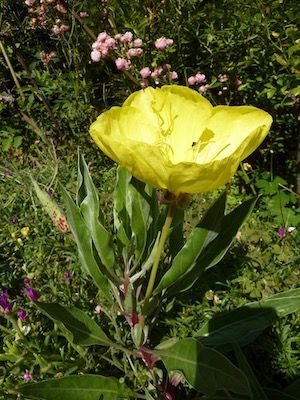Oenothera Biennis

Latin name: Oenothera biennis
Family : Onagraceae
Common names: Common evening-primrose, evening star, sundrop, German rampion1
Etymology
From the Greek 'oenos': wine and 'thera': beast from Latin 'biennis': biennial
II- Legends and traditions
An ancient legend attributed to the evening primrose characteristic abilities to tame wild animals due to its pungent odor.
III- Botanical description
Description: Biennial oleaginous herbaceous plant of 50cm to 1.50m with robust stems, not very branchy, spotted with red and hairy. The upper leaves are elongated, lanceolate and sessile. The lower leaves are long-stalked, arranged in a rosette at the base of the stem. The flowers are yellow with 4 petals opening at nightfall and wilting the next day at noon. The fruits are narrow, long, ridged pods containing seeds.
Habitat: Native to North America, the evening primrose has spread in Europe on roadsides, banks, rubble, embankments.
Flowering: from July to September
Harvest: The roots are harvested before flowering in the first year, otherwise they become hard. The leaves are harvested all year round. The seeds are wrapped in pods which are harvested after flowering.
Pars used : Evening primrose oil from seeds
IV- Active ingredient
|
Evening primrose oil |
|
Essential fatty acids linoleic acid gamma-linolenic acid (precursor of prostaglandin which acts on the menstrual cycle) Fat (20 to 25%) Vitamin E and F |
V- Therapeutic uses
Properties
|
Evening primrose oil |
|
• Anti-inflammatory • Cosmetics • Harmonizing menstrual cycles |
Indications
Improves the suppleness and elasticity of the skin. Regulates the hydration of the skin and protects it from premature aging. Regulates menstrual cycles and relieves ailments: cramps, headaches, fluid retention, irritability, breast tension.
Dosage
The recommended dosage is 3 g to 6 g per day of evening primrose oil standardized to 8% gamma-linolenic acid by epileptics for oral use in adults. And from 2 to 4g in children. Distribute the intake throughout the day, preferably in the middle of the meal, for better assimilation. When it comes to treating the various disorders associated with premenstrual syndrome (breast tension, irritability, water retention, etc.), it is advisable to take 10-day per month cures during the second half of the cycle.
VI- Precaution of use
Contraindication
Pregnant, breastfeeding women infants epileptics
Interactions
The oil can interact with blood thinners, antidepressants, and neuroleptics.
Caution
The oil can sometimes cause nausea, headache (on empty stomach) and diarrhea if overdosed.
1 https://en.wikipedia.org/wiki/Oenothera_biennis


